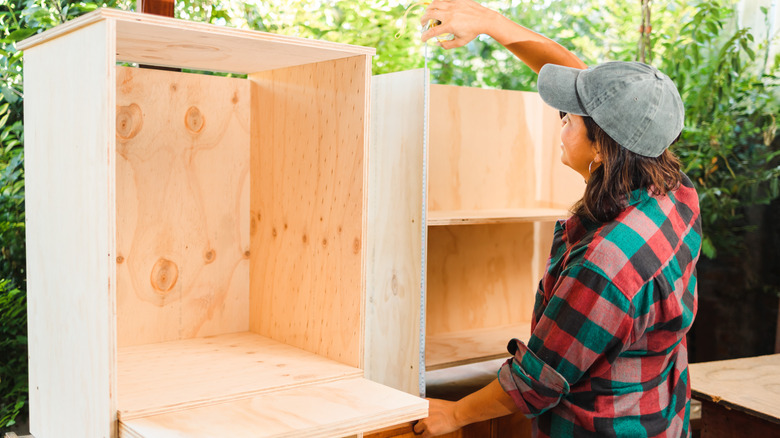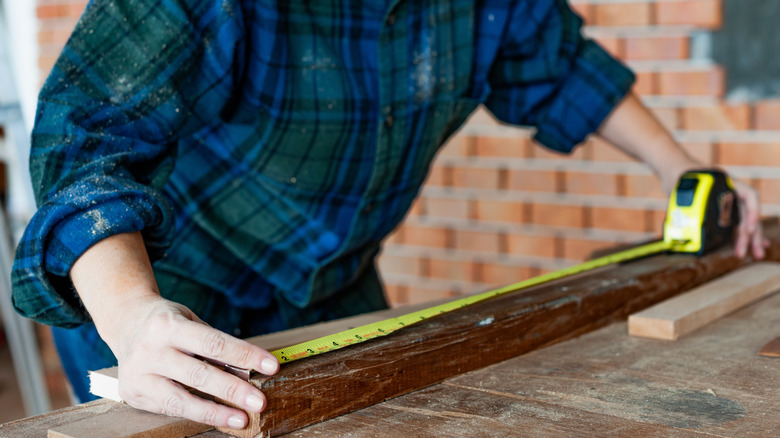The Wood Measuring Hack That Is The Most Quick And Accurate
Measure twice, cut once. If only it were that simple. Wait a second — it is. What this justified cliche says, of course, is it's wise to double-check your measurement before making your cut. This saves time and material, so it's pretty practical advice. But what if you could measure twice — as in, make two measurements — and be just as accurate? It turns out you can, and the fix is clever and easy to do. Mark a line 10 inches from one corner, then measure over to your mark from the opposite side and add those two numbers. Voila.
Taking inside measurements, such as a window casing, between door jambs, the inside of a cabinet, or a frame to fit a rail, isn't as easy or intuitive as your typical outside dimension. There are ways to accurately measure corners with ease, but one thing is for sure: rolling your ruler won't work.
You've no doubt seen it a hundred times, and you've probably done it yourself. You've probably butted the metal tab (tang) of your tape measure against the far edge and bent the thin metal rule to fit in the opposite corner as best you could. From there, you guessed. If you were lucky, you cut the piece too long and slowly trimmed away the excess little by little to sneak up on a snug fit. More often than not, you overcut and had to grab a whole new workpiece. Both options are less than ideal. To avoid either scenario, check out this measuring trick.
How to hack inside measurements
You can measure from one inside point any amount you like, so long as you have enough room to make your mark and for your tape measure when taking the returning dimension. Using 10 inches keeps the math simple with a nice round number that can be easily added to your other measurements. Starting from one end or corner, measure over 10 inches and make a mark. Now, measure from the other end to your mark. Add that number to the 10 inches, and you've got your length. Fast, accurate, easy.
When you take your measurement back to the board to mark for your cut, be sure to align your cutting blade with the "waste" side of your cutline. The waste is your offcut — the piece you won't be using. If you cut to the inside of the line, surprise, your board is too short. Even if you try cutting straight down your pencil line, thinking you're being uber accurate, you risk overcutting. Most modern circular saw, table saw, and miter saw blades will leave a kerf (the cut made by your saw) that's either 3/32 or ⅛ inch wide. Splitting your cutline means you could be cutting some amount from your workpiece. That may not seem like much, but it's enough to make your piece too short, sending you back to the big box store for another board. Mark a nice clean line, favor the waste side, and make a square cut.
More tape rule tricks
Alternatively, you could use a 10-inch piece of scrap. Butt the piece to your corner and clamp it in place if necessary. From there, do the same thing as above. Run your tape from the opposite end to the clamped piece, aligning your measurement with the outside end of the scrap. Alternatively, you could use a framing square instead of the scrap. When using a measuring tape, avoid making a mistake by using the number on the housing, as it represents that case's length.
For smaller inside dimensions, such as on a case or a box, burn an inch. Rather than relying on your tape measure's hook, align the 1-inch mark with one side and subtract an inch from the total. Also, your tape measure has grooves on the metal tip that you can use to scribe a line on your workpiece or mark screw locations.
When thinking about tape measures, we picture the bulky 25-footers. They're heavy, and you may use only the first few feet. Smaller options are available — 16, 12, 10 feet, and smaller. Pick the one that fits your kind of work. Finally, it's smart to keep a bunch of tape measures scattered around your workspace, but once you start a project with one tape measure, stick with it. Don't grab another because it's handy, thinking all tape measures are created equal. You'll be more accurate if you stick with one tape throughout a project.

